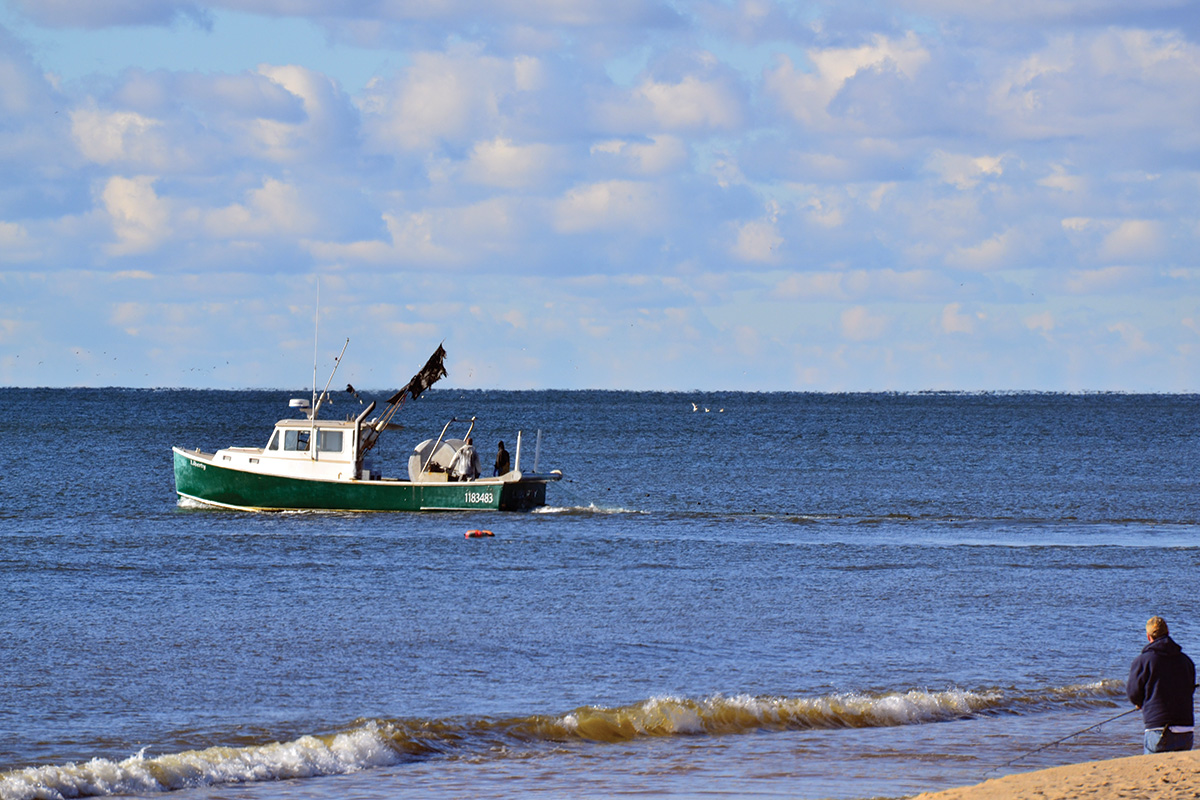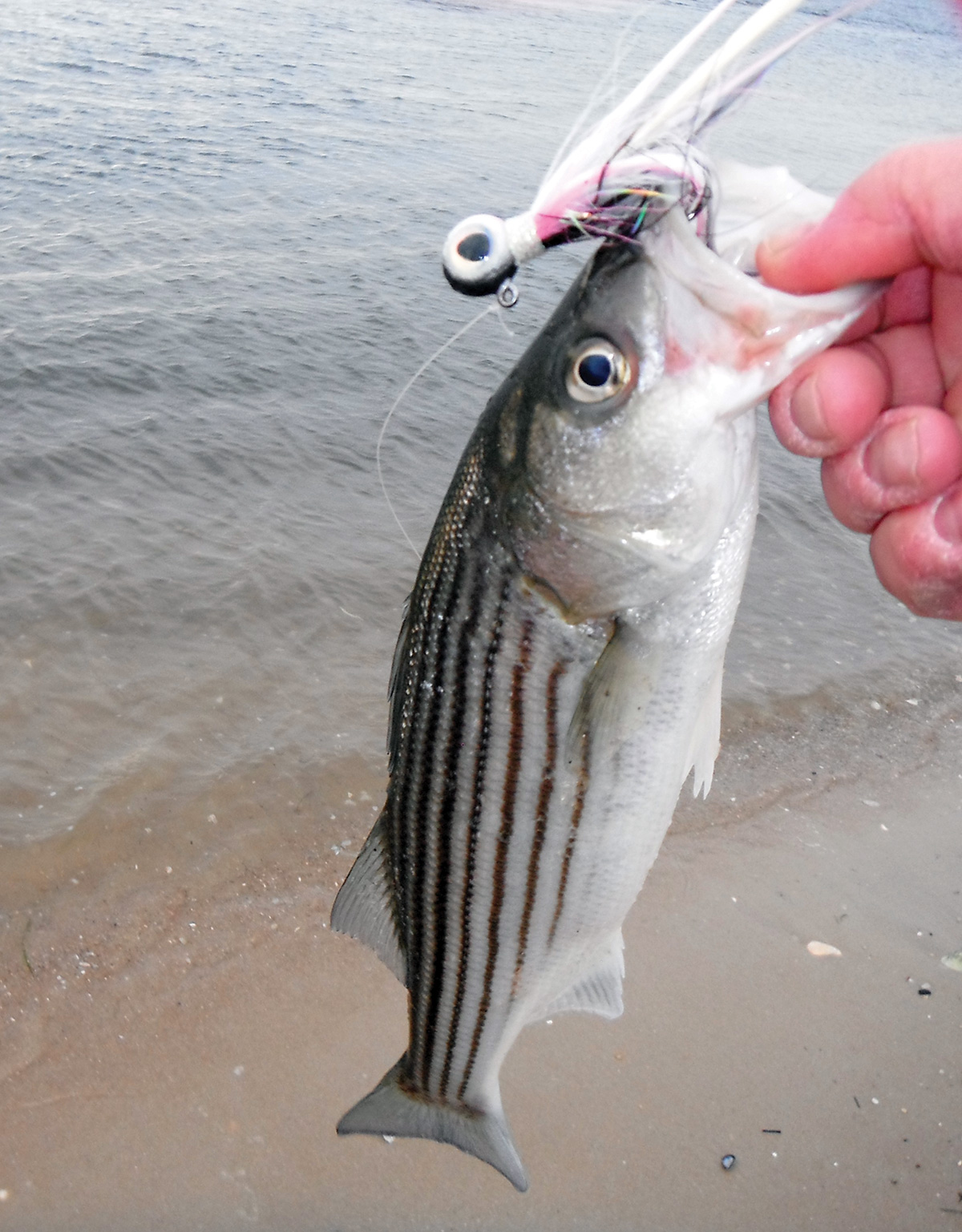
It’s time something is done about the escalating use of gill nets along the Island’s shoreline. There is no netting allowed within 1,000 feet of the beach along the western half of the South Shore. While 1,000 feet may seem insignificant, it is still better than to the east, where on calm days, netters can put their stern literally on the beach and then run their nets offshore from there. It became so bad at times along stretches of the South Fork when bass are running the beach, many casters gave up fishing those beaches out of frustration, according to Ken Morse of Tight Lines Tackle in Sag Harbor. After all, how much confidence can you have fishing an area strung with nets every couple of hundred yards.
Savio Mizzi who normally spends much of the fall running the sand beaches between Montauk and East Hampton, gave up fishing the beach this fall after being frustrated by the maze of nets spread along this stretch, on top of having to watch bass after bass that did not make the 28 to 38-inch slot size getting thrown back dead. Many people also questioned how the same boats could harvest so many bass day after day with the limited number of tags allotted them?
It doesn’t seem right that a practice benefitting so few can have such a negative impact on a recreational fishery that involves thousands and is worth far more economically. The past few years, the number of complaints have risen dramatically, and this fall was the worst in as long as I can remember. The complaints this year were not limited to just nets being set so close to the beach, or the number of nets, or dead bass. We also heard about threatened and protected species like dolphin, seals, sea birds, great white shark pups and even a baby whale killed after being trapped in nets. We also heard from a boat fisherman who inadvertently became entangled in a gill net while running the beach back in October.
The bottom line is that gillnetting is a dirty, non-selective fishery. New York is the only state in the Northeast where striped bass can be taken by gill nets. There is no commercial fishing allowed for striped bass in Maine, New Hampshire or Connecticut. Massachusetts has a rod and reel only commercial striped bass fishery with no netting allowed, and there are bills currently being proposed to reduce and eventually eliminate commercial rod and reel fishing for striped bass, and raise penalties for poaching them.

Rhode Island is rod and reel only, with the exception of a limited trap fishery which allows fish to be returned alive. There is no sale of striped bass allowed in New Jersey. When you look around, New York sticks out like a sore thumb as the one holdout with a non-selective striped bass fishery. Maybe it’s time our legislators and fishery managers take the bold step of limiting New York’s striped bass fishery to rod and reel only.
The striped bass fishery is not as healthy as it may appear to some, and not as good as it may appear to others. If you fished from a boat in Montauk, especially around the moons, you’re probably thinking that the fishery has never been healthier. Ditto for the mobs fishing the Cape Cod Canal this season, where they witnessed one of the best striped bass seasons in a very long time. Add the miles of striped bass that stretched along the South Shore for most of November and into December, and the issue becomes even more complex.
The bottom line is that striped bass deserve protection that errs on the side of conserving these valuable sport fish. While gamefish status (no commercial sale) might be the ultimate solution, the chance of seeing that happen anytime soon is probably a pipedream. Limiting commercial harvest to rod and reel only would be major step in the right direction. At least it is a selective harvest method, is no threat to endangered species or mammals, and when the fish are not in feeding mode, they can’t be caught. Short of that, tightening up netting regulations to reduce bycatch and illegal harvest would be a move in the right direction. The tagging system also needs to be overhauled, and the criteria for qualifying for tags revisited. It’s one thing when full time commercial fishermen are supplementing their income with striped bass, but it’s tough to swallow when guys collecting fat pensions with no real commercial fishing background are making a few extra bucks selling stripers. If the tag system is to remain in place, there should be no allowance for passing tags onto someone else to fill. Instead of passing unused quota onto those with tags, how about reducing mortality by leaving those tags unfilled?
And when it comes to illegal harvest, we have a long way to go where “recreational” anglers are concerned. Abuses are rampant and reports of boats with two or three anglers keeping upwards of a dozen big bass or more when the fish are on the bunker schools come to our attention every year. The illegal sale of stripers through the back doors of restaurants and fish markets is usually the motivation for such excessive abuse. It’s time New York gets tough with penalties. Never mind these slap on the wrist fines – confiscating gear and even boats in some cases would make people think twice about ignoring regulations. And do charter boats really need to keep fish for the captain and mate? Two more fish a trip might not sound like much but multiply it by the number of trips a boat makes, and the number of charter boats targeting stripers and you wonder if it’s worth taking those fish out of the fishery. Kudos to the captains who limit the day’s catch to the number of anglers in the charter and realize that maintaining a healthy striped bass fishery is critical to their own future.
Those who argue against commercial fishing for striped bass, and want larger size limits or slot limits based on the fishery being on the verge of total collapse will have a difficult time being credible. I don’t think anyone can say for certain why stripers have been avoiding the surfline in many areas, but to those who ply the surf it certainly appears the fishery is in dire straights. It may not be as healthy as it can or should be but there is ample evidence it is nowhere near collapse. While the areas mentioned earlier saw epic fishing for bass at times, the pattern of just a couple of areas holding large numbers of fish is not indicative of a healthy fishery.
On the positive side are two very good Chesapeake year classes (2011/2013) and more recently, two very good year classes from the Hudson. Those fish matriculated into the coastal fishery this season in a big way but were for the most part still short of the 28-inch minimum size. These fish need to be protected as they reach legal size. There is a great opportunity now to insure these larger than average year classes remain healthy. While some were opposed to the 32-inch size limit proposed at the last ASMFC public hearings, a 32-inch size limit would insure that many quality fish remain in the fishery, both for reproduction and also to provide better quality for rod and reel anglers.

We have seen the correlation between size limits and the size of fish that remain in the fishery. People complain about the size limits of fluke, which did frustrate many anglers, especially when the limit was at 21 inches, but even now at 18 inches, the quality of the fish we are catching is far better than when we fished under smaller limits. Back in the 70s with a 14-inch size limit in place, you would be happy to catch a few “keepers” at 14 inches. How many people would be happy with that these days? Reports this past season revealed far more 18-inch plus keepers, as well as many limit catches of these quality fish. Some of the best striper fishing we ever had was at least partly attributable to the 36-inch size limit. Those who were fortunate enough to experience the years of incredible Montauk blitzes that turned the ocean to a froth will recall the abundance of teen size and 20-pound class stripers that resulted from a 36-inch size limit allowing those fish to develop. It would be a shame to see this latest crop of stripers depleted before they attain quality status.
Make no mistake about it, recreational anglers harvest far more stripers than commercial fishermen. In fact, striped bass were at the top of the list when it came to top species by pounds harvested by recreational anglers in data compiled by NOAA Fisheries and presented in the 2016 U.S. Recreational Fisheries Report. Over 20 million pounds and 1.6 million fish were harvested by recreational anglers in 2016 – all the more reason to classify striped bass as a recreational fishery.
Back in 2014, the ASMFC’s Atlantic Striped Bass Management Board submitted Draft Addendum IV to Amendment 6 to the Interstate Fishery Management Plan for Atlantic Striped Bass. It was subsequently approved in October of that year and was in response to results of the 2013 Atlantic striped bass benchmark assessment indicating fishing mortality (F) target, and female spawning stock biomass (SSB) had been steadily declining below the target since 2006. This meant that even though the stock was not overfished and overfishing was not occurring, SSB was approaching its overfished threshold and stock projections showed SSB would likely fall below the threshold in the coming years. In addition, a similar decline had been observed in total harvest. This resulted in the reduction of the recreational daily bag limit on striped bass from two fish to one per angler, and the reduction in commercial quotas coast-wide by 25 percent.
But was this enough? Things are apparently on the right track but there were those who were quick to jump at the opportunity to liberalize the regulations. Back in February, 2017, the Commission’s Atlantic Striped Bass Management Board initiated the development of Draft Addendum V to Amendment 6 to the Atlantic Striped Bass Fishery Management Plan (FMP) to consider liberalizing coastwide commercial and recreational regulations. This was in response to concerns raised by Chesapeake Bay jurisdictions regarding continued economic hardship endured by its stakeholders since the implementation of Addendum IV and information from the 2016 assessment update indicating fishing mortality was below the target.
According to the results of the 2016 stock assessment update, the Atlantic striped bass stock is not overfished and overfishing is not occurring. Furthermore, Addendum IV successfully reduced fishing mortality to a level below the target (F in 2015 is estimated at 0.16), and length‐frequency data from the catch in 2015 indicates a strong presence of the 2011 year class which was anticipated, and in fact did, join the coastal spawning population this year.
Fortunately, in May The Commission’s Atlantic Striped Bass Management Board chose to not advance Draft Addendum V to Amendment 6 to the Fishery Management Plan (FMP) for Atlantic Striped Bass forward for public comment. Instead, it decided to wait until the release of the results of the 2018 benchmark stock assessment before it considered making changes to the management program.
There is a very good likelihood that the assessment will be positive. Hopefully, the management board will once again err on the side of caution and allow the fishery to continue to thrive.




